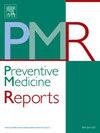个人、家庭和地区社会经济地位指标与人体测量指数之间的关系
IF 2.4
3区 医学
Q2 PUBLIC, ENVIRONMENTAL & OCCUPATIONAL HEALTH
引用次数: 0
摘要
目标超重和肥胖是导致非传染性疾病发生的主要决定因素。我们的目的是检验人体测量指数和社会经济地位之间的关系。本研究是一项基于人群的横断面研究,对2016年5月至2018年8月在伊朗西南部参加Hoveyzeh队列研究的9846名35至70岁的成年人进行了研究。方法对3个层次的社会经济指标与8个人体测量指标之间的关系进行评价。采用多元逻辑回归对潜在混杂因素进行校正。结果9846名受试者的平均±sd年龄为48.80±9.20岁,女性5820人(59.1%)。在社会经济指标中,剔除潜在混杂因素后,财富指数和townsend剥夺指数(其次)与人体测量指标的关系最强。相比之下,教育程度与人体测量指数之间的关系大多较弱,没有一定的趋势。在人体测量指标中,腰围、腹容积指数和腰高比与社会经济指标有显著的相关性。腰臀比指数的相关性最弱。结论本研究显示社会经济指标与人体测量指标之间存在显著相关性。经济因素的作用比社会因素更具有决定性。本文章由计算机程序翻译,如有差异,请以英文原文为准。
Association between individual, household, and area-level socioeconomic status indicators with anthropometric indexes
Objectives
Overweight and obesity are major determinants that contribute to the occurrence of non-communicable diseases. We aim to examine the association between anthropometric indexes and socioeconomic status.
Study design
This study was a population-based cross-sectional study conducted on 9846 adults aged 35 to 70 years who participated in the Hoveyzeh Cohort Study from May 2016 to August 2018 in southwestern Iran.
Methods
We assessed the relationship between three levels of socioeconomic indicators with eight anthropometric indexes. Multiple logistic regression was used to adjust the potential confounders.
Results
The mean ± sd age of 9846 participants was 48.80 ± 9.20, and 5820 (59.1 %) were female Among the socioeconomic indicators, after control for potential confounders, the wealth index and, in the second place, the townsend deprivation index had the strongest relationships with anthropometric indexes. In contrast, the relationships between education and anthropometric indexes were mostly weak and without certain trends. Among the anthropometric indexes, waist circumference, abdominal volume index, and waist to height ratio had a statistically significant association with socioeconomic indicators. The weakest associations were found for the waist to hip ratio index.
Conclusion
This study showed significant associations between socioeconomic and anthropometric indicators. The role of economic factors is more decisive than social factors.
求助全文
通过发布文献求助,成功后即可免费获取论文全文。
去求助
来源期刊

Preventive Medicine Reports
Medicine-Public Health, Environmental and Occupational Health
CiteScore
3.90
自引率
0.00%
发文量
353
 求助内容:
求助内容: 应助结果提醒方式:
应助结果提醒方式:


